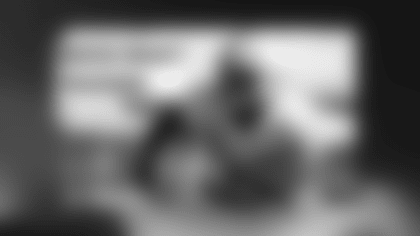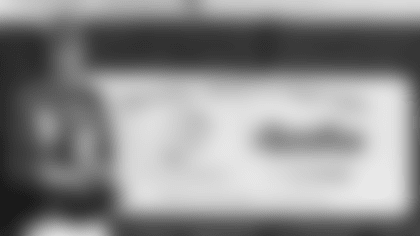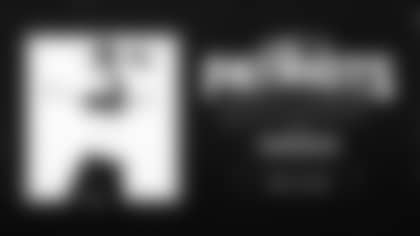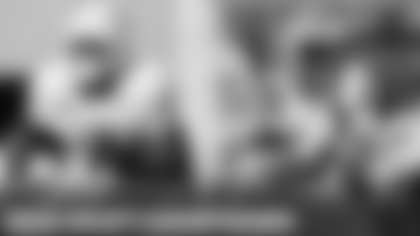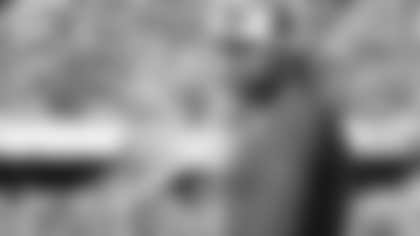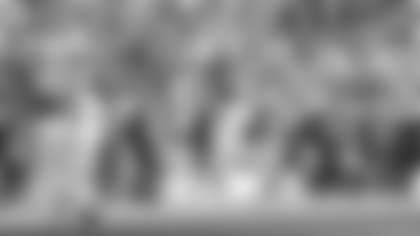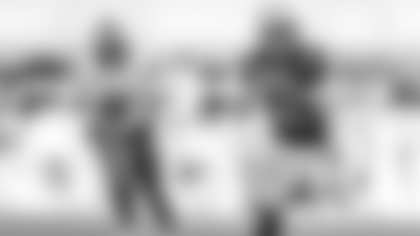The Patriots post-game media availability following another disappointing loss to the Bills was as candid as you'll ever encounter in a typically tight-lipped place like New England.
From the players to head coach Bill Belichick, there was palpable frustration with how things unfolded offensively and comments by certain players critiquing the overall direction of the offense.
Although his remarks weren't as inflammatory towards the coaching staff as others, quarterback Mac Jones was open about the Patriots game plan heading into Thursday night's pivotal divisional matchup with Buffalo.
"I think the coaches have a really good plan for what they think is going to work for that week. Today was kind of like the quick game, get the ball outside, make everyone tackle. That was kind of our plan," Jones told reporters at his post-game press conference.
New England's strategy had some merit to it. The Bills defense entered the week ranked 27th with a missed tackle rate of 14%. In theory, quick passes to receivers in space designed to pick up yards after the catch against a defense that struggles to tackle is a good idea.
However, the metrics also show that the Buffalo defense is actually very good at limiting yards after the catch, allowing the third-lowest YAC per reception in the NFL (4.43). Furthermore, many of those missed tackles piled up when the Bills were missing key starters due to injuries, such as linebacker Tremaine Edmunds (three games) and safety Jordan Poyer (four games), who both played in Thursday night's game.
Another flaw in the plan is that the Patriots lack dynamic YAC merchants to force those missed tackles and rack up yards after catch (11th in YAC/reception), which is why they needed cornerback Marcus Jones to play three snaps on offense. Plus, they didn't even funnel the game plan through their better ball carries at receiver, such as Jonnu Smith and Kendrick Bourne, who had a combined four targets and each played less than 40 percent of the offensive snaps.
Despite having a flawed plan going into the game, the Patriots offense manufactured a touchdown drive with solid, aggressive play-calling and a new wrinkle with Jones at receiver.
The Pats came out throwing on early downs with a quick-game completion to Hunter Henry (nine yards), a second down run to move the chains, and then three-straight play-action or RPO calls, including an 11-yard completion to Nelson Agholor off play-action in the sequence above.
On the touchdown pass to Jones, the Patriots called a run-pass option (RPO) into a nickel blitz by the Bills that was perfectly timed. With Taron Johnson blitzing from the slot, the deep safety (Damar Hamlin) is tasked with replacing Johnson in man coverage in the pressure scheme. Mac pulls the ball and throws to the screen option, and with enough of a block from DeVante Parker, the explosive rookie is shot out of a cannon.
Unfortunately for the Patriots offense, that was the only sign of life for the rest of the game. The Bills mostly stopped blitzing Mac after they caught them on Jones's touchdown, calling just two more blitzes the rest of the way, and sniffing out the Pats screens easily. Buffalo didn't give up much YAC after that either, surrendering 92 yards after the catch on 21 receptions (4.4).
Following the well-scripted touchdown drive on their second possession, unofficial play-caller Matt Patricia also got away from what was working. Patricia called just two play-action passes the rest of the game, six total, and the aggressive early-down passing plays disappeared too.
For example, after three-straight runs by Rhamondre Stevenson produced 24 yards, the Pats had another promising drive going to start the second half. But, as you can see above, it wasn't like they were opening giant holes for Stevenson to run through. Instead, it was the second-year breakout star churning out yards after contact and pushing the pile at a ridiculous rate.
With three-consecutive first-and-tens, one would hope that the play-caller would recognize that the running game was bound to dry up when the unstable yards after contact production ran out. Rather than calling play action, which worked earlier in the game, Patricia called for another run on a toss to Stevenson that lost four yards.
The negative play, adding to New England's league lead in that category, produced a second-and-14 where Jones forced a pass downfield to Henry that Poyer nearly intercepted. Then, the Patriots waved the white flag with a downfield screen to Meyers on third-and-14. After making it to first-and-ten from the Buffalo 44, the punt team ran onto the field.
The Patriots offense has more than a coaching issue. New England's offensive line is a mess, they lack explosive playmakers, and then there's the quarterback's year-two regression.
But an offense with mostly the same cast of characters doesn't plummet from tenth in EPA per play in Jones's rookie season to 26th on its own. If your plan to take down an elite operation like the Bills is best suited for a rookie who was drafted to play primarily on defense and special teams, is it really a good plan? If you are the Dolphins or 49ers, sure, get Tyreek Hill and Deebo into space and force a Bills defense missing some key pieces to tackle. That's not the Patriots.
The Patriots are also one of the league's best passing offenses off play-action, with Jones ranking ninth in yards per play-action attempt (8.8). Yet, Mac's play-action rate is 28th among 32 qualified quarterbacks, and they only dialed it up for one drive on Thursday night.
There's evidence all over the place that the Patriots aren't putting players in a position to succeed offensively, from week-to-week game plans to in-game play-calling and responsibilities. Patricia has a great relationship with Belichick that spans over two decades. But the results speak for themselves when it comes to the direction of this offense.
Here are three more takeaway and quick-hit film notes from the Patriots loss to the Bills After Further Review:
1. Breaking Down Patriots QB Mac Jones's Film vs. Bills Defense
Grinding through the Patriots offense's film was a tough watch for many reasons, especially following last week's performance where they got the passing game going against Minnesota.
From this perspective, Thursday night's game film wasn't one of those tapes where Jones frequently missed open receivers due to things in his control (missed reads, poor accuracy, etc.). The Pats didn't try to push the ball downfield much, and when they did, the pressure became a significant issue that Jones and his receivers couldn't overcome.
Although the things around him were primarily at fault, one of Jones's poor habits from his second-year regression continued on an intentional ground, near-safety in the second quarter. Despite the defense closing the middle of the field with a weakside safety rotation, Mac still opens to the backside of the formation, where both routes are covered. If he opens to the three-receiver side, Henry is open for a quick completion, which was the purpose of play.
Speaking to other quarterbacks and coaches, several variables go into the direction in which the QB opens at the top of his drop. Obviously, the two biggest ones are the type of coverage and how the route combination marries with the quarterback's reads.
Without knowing Jones's coaching and mental process, it's impossible to determine why his eyes are not ending up in the right places. But it's a reoccurring theme on his year-two tape.
2. Patriots Defense Finds a Successful Formula vs. Bills QB Josh Allen
The Patriots defense versus the Bills offense and quarterback Josh Allen was a heavyweight fight. Ultimately, Allen got the best of them by adding 0.33 expected points per drop-back (83rd percentile). But did so on 6.8 passing yards per attempt and with three turnover-worthy plays. Both sides landed some punches.
New England is known for spinning the dial and figuring out ways to play their brand of man coverage against superior receiver groups, but even for them, they broke the dang dial.
Belichick opened the game in a six-defensive back dime package with three safeties and three corners. Right out of the gate, they began the exotic coverage rotations and disguises.
On Buffalo's first passing play, the Patriots show a single-high structure to Allen before the snap. At the snap, outside corner Jonathan Jones falls into a half-field safety role as the Pats form a cover-two zone, which is not a common way to get to this structure. The rotation forces Allen to hold the football and eventually check it down.
The Patriots played most downs with a two-high safety shell pre-snap and rotated into a variety of different coverages from there. Above, they start in a two-high structure and then spin into a cover-three zone where the weak side safety "buzzes" down into the shorter hook zone. Allen doesn't see safety Kyle Dugger dropping underneath the deep comeback route after the play-action fake, and Dugger and rookie corner Jack Jones nearly come up with an interception.
When the Patriots played man coverage, they often used a safety to leverage Bills slot receiver Isaiah McKenzie's crossing routes out of their one-cross or one-robber schemes.
Here, the Patriots execute a perfect rep of one-cross. Adrian Phillips cuts off McKenzie's crossing route with Myles Bryant in an outside leverage position, and then Bryant replaces Phillips as the "robber" in the middle of the field. The exchange perfectly syncs up with Stefon Diggs's route, and Allen has nowhere to go with the football.
In the next section, we'll address a few plays that the Patriots defense probably wants back. But they played high-level coverage in the backend and challenged Allen throughout the game.
3. Situational Execution and Coaching Need to be Better in Every Area
As we wrote in game observations, the Patriots lost to a better Bills team on Thursday. However, the game could've been much more competitive with better coaching and situational football.
New England is squandering too many chances in all three phases because it lacks attention to detail in crucial situations, such as the end of the half and a couple of critical red zone sequences.
Starting with butchering the 1:20 drill to end the first half, burning two timeouts to gain one yard for a new set of downs when time and field position are all that matters was a rough sequence.
Defensively, they lost too many four-point plays in the red zone in the first half, allowing Buffalo to play with a comfortable lead. The first one came when Bills offensive coordinator Ken Dorsey knew the Pats would be in man coverage on third-and-2, so he motioned McKenzie into the bunch and ran a rub route to pick up the first down. An offensive coordinator using motion and attacking a tendency to pick up a third down. Would you look at that?
Ideally, we would've liked to have seen the Pats coaching staff break a tendency there and fall into a zone after following the motion, which Buffalo wasn't expecting. If Jack Jones stays in the flat rather than covering Davis in man, like in cover-two, he probably takes out McKenzie.
The Patriots also "fell out of coverage" too early when Allen extended the play on Davis's touchdown. They are in man coverage and cover the play well initially, with McCourty cutting off McKenzie's crosser and tight coverage across the board. They even have Mack Wilson spying Allen with mirrored T/E stunts in the four-man rush. Good call. But Jon Jones gave up on the play too early, and Bryant, who replaced McCourty as the robber, could've read it better too.
New England's offense failing to score before the half and the Pats defense coming up short on four-point plays in the red zone were two big reasons why this game wasn't closer in the end.
4. Other Quick-Hit Film Notes From the Patriots Loss to the Bills
- The only offensive player immune to this coaching staff and offensive line is Rhamondre. Another 45 yards after contact on 54 total rushing yards. His contact balance, power, and elusiveness are elite. He had no business averaging 5.4 yards per rush.
- Hard to give anyone a passing grade on the offensive line. For a fourth tackle, it could've been worse for Connor McDermott (three hurries). Cole Strange was fine (one hurry), but he's still treading water out there and needs Andrews. Trent Brown looked terrible after the game dealing with an illness. Still, it feels like he's going rogue on some plays where he's throwing cut blocks when the other tackle is in standard pass pro. He needs to get right physically and maybe have a chat with Scar. Andrews gutted it out, and outside of one whiff on a stunt pass-off, Onwenu was okay. Overall, not good. 39.5% pressure rate and 60 yards after contact on 60 total rushing yards.
- When the play-caller dials up mostly quick-game concepts on early downs, and the offensive line can't pass protect on third down, it's tough to assess the receiver situation. The lack of game-breakers is a given. But these pass-catchers produce when Mac has time in the pocket. They need to get more out of this group.
- The fact that the game plan was to generate YAC off quick passes and Jonnu Smith only played 17 snaps makes zero sense.
- Pats EDGE Josh Uche was the most impactful player on the team with five QB pressures (two sacks, a hit, two hurries) and five stops. His "ghost" rush to beat backup left tackle David Quessenberry on the strip sack would've made Von Miller proud.
- The Pats run defense only allowed 3.6 yards and a 35% success rate on 37 rush attempts. A big part of that was NT Davon Godchaux leading the charge with the Pats sitting in two-high shells on early downs. Godchaux had a team-high ten tackles and five run stops. He was two-gapping at a high level and shedding every single block that came his way in the run game. Godchaux dominates Bills C Mitch Morse.
- Matthew Judon made three impact plays with a drawn hold to save a TD, one QB hit, and a run stuff. He was also used as an overhang player out wide to set the edge vs. Allen. Buffalo also chipped him when they could in a game that wasn't exactly a pin-the-ears-back plan. Overall, they need to find ways to get more out of him. Move him inside like they used to do with Hightower while someone else sets the edge?
- You'll take the yards underneath over the big plays downfield. But it would help the Pats defense to have a more athletic MIKE LB in these matchups than Ja'Whaun Bentley. Check-downs into his zone produce too many yards. It's not his game.
- I'm trying to figure out what to make of Jonathan Jones. The stats are bad (nine catches, 89 yards, and 2 TDs). He stopped playing on the Davis TD and got burned by Diggs on his TD. But they didn't give him much help on Diggs, and he was competitive on several plays in man coverage. J.C. Jackson had a similar issue. Good at times but too inconsistent to hold up against an elite receiver.
- I'm excited for the future with the rookie Joneses. However, Jack Jones desperately needs to learn coverage discipline and how to read receivers from off-coverage and zone/bail techniques. He's getting beat on verticals too often and was almost burned by it this week if it wasn't for Judon drawing a hold. Marcus held up well in 23 coverage snaps, with two incompletions on two targets. He needs to play more.
- They protected him more this time, but the Pats continued to roll out Myles Bryant vs. Isaiah McKenzie in man coverage. McKenzie had him beat more than once. Bryant was lucky to give up only one catch. He also gave up a third-down completion on an out-breaking route when he had outside leverage/inside help. Can't happen.
- Devin McCourty is a Patriot legend and the ultimate leader. As a fan, it's nothing but love. Still, his reaction time or game speed, however you want to look at it, is diminishing. He had cut coverage on McKenzie in the red zone on Diggs's TD and, despite having inside leverage, still got burned. It feels like he's not seeing it as quickly.








